This post is a part of the complete wool pillow buyers guide
You may not realize it yet, but your pillow could be the dirtiest piece of bedding in your bedroom. In most cases when doing laundry, people only consider the duvet, comforter, bedsheets and pillowcase.
The pillow itself only crosses most peoples mind after multiple months have passed. Sometimes, people start sneezing uncontrollably only to remember that their pillow needs cleaning.
When it comes to wool pillows, even a dirty pillowcase could affect the wool stuffing inside the pillow, and if it goes uncleaned, you will likely need to buy a new pillow. And purchasing a new pillow each time it gets dirty, is an expensive way to live.
So, if you own a wool pillow you would do best to learn how to wash it, as well as how frequently to do so. Afterall, cleaning your pillow makes it last longer, and you will also enjoy some health benefits.
Below is a step-by-step guide on how you can wash and dry your wool pillows and keep them fresh.
Before You Start Washing Your Wool Pillow
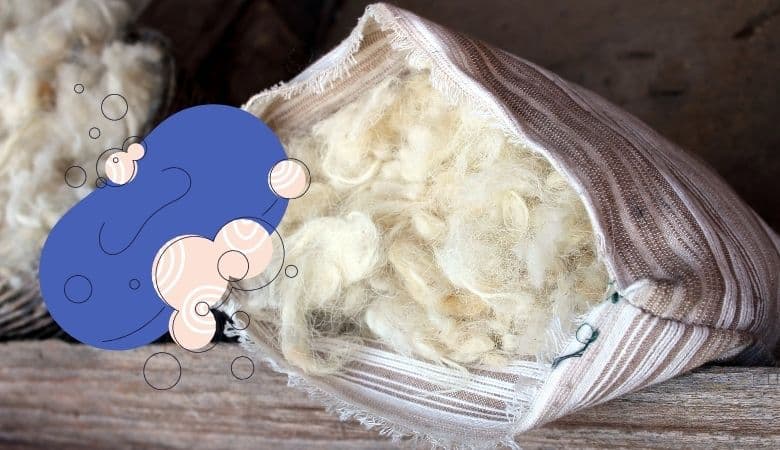
1. Check the label
There is a product description tag on the edges or sides of the pillow with usage instructions. Pillow makers add these tags to guide you on cleaning and maintaining the pillow. Follow the instructions strictly whether you agree to them or not.
Check whether the pillow should be washed by hand, machine, or tumble-dried. Most modern pillows are machine washable to make them easy to maintain.
2. Check your washing machine
The type of washing machine matters a lot. Washing wool pillows require you to use manually controllable machines to start and stop in between cycles and skip agitation.
An agitator will affect your fibers because they clump and matt. If you can bypass your machine controls, you can save your pillow’s comfort and firmness. If the machine is automatic and with minimal control, you should wash it with your hands.
How to Wash a Wool Pillow in a Washing Machine
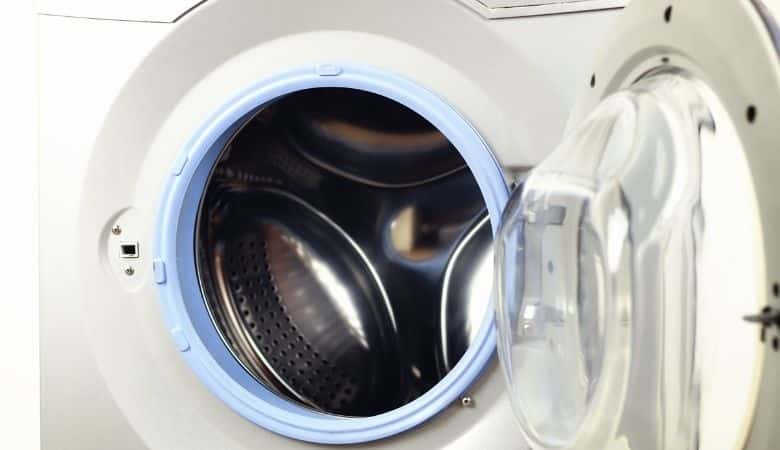
You can wash your pillow in a top-loading or front-loading machine.
Step 1: Remove the pillowcase
If you are using a pillowcase on your pillow, wash them separately. If you use your pillow without a case, move to the next step.
Step 2: Set the washing cycle
Pick the suitable cycle that either tumbles or spins the water out of your clothes on your washing machine. You can also consider the pillow cover material to help you decide the appropriate washing cycle.
By doing this, you maximize the pillow’s cleanliness while protecting the fabric and wool filling. Always set the cycle to gentle when washing your pillows to avoid clumping the wool fibers.
Step 3. Set the water temperature
When setting the water temperature, do not make it too hot. Use either warm or cold water. Hot water is good for killing germs, but it can shrink the wool in your pillow.
Use cold water for wool pillows on the gentle cycle because the stuffing is delicate. It also saves energy and protects the environment.
Step 4: Add detergent and conditioner
First, determine the amount of detergent suitable for your pillow and where you need to pour it. Detergent refreshes and whitens your pillow cover. Wool pillows can also use some conditioner to soften the material.
Do not add excess detergent or fabric softener that may tamper with the quality of the filling. If the pillow cover is deeply stained, add bleach to the washer.
Step 5: Load the washing machine
If you are using a top-loading washing machine, place two pillows facing each other to balance the load. This prevents your wool pillow from turning in the washing drum and ruining the fabric and stuffing.
Front-loading washing machines require you to load your pillow with other fabric like towels to balance the load.
Do not add a lot of laundries that would affect the level of cleanliness to intend to achieve.
Step 6: Start the washing machine
Close the machine’s door and press the start button. Newer washing machines can indicate if the door is closed correctly. If yours had no indicator, you could personally check to confirm to avoid accidents. Let it run for 15 minutes before you take them to the dryer.
How to Wash a Wool Pillow by Hand
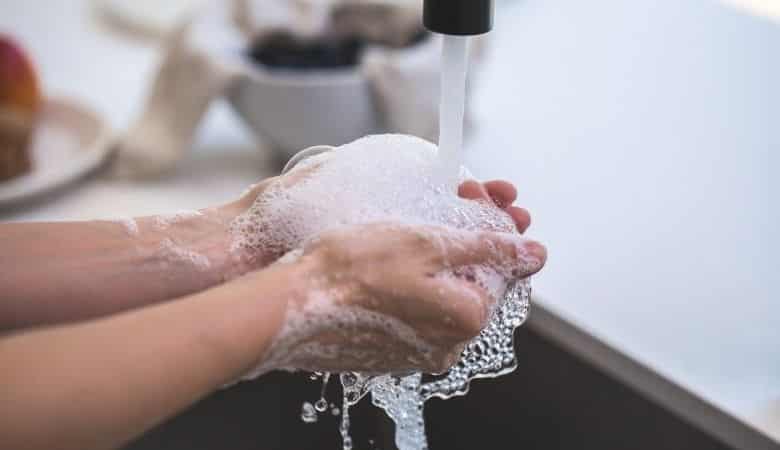
If you want to wash your pillow by hand, you need a bathtub or a large sink, water, soap, or detergent.
Step 1: Remove the pillowcase
Take your pillow out of the pillowcase and wash it separately. Most pillowcases for wool pillows are either cotton or bamboo so that you can wash them in the washing machine.
If the pillowcase is stained, pre-treat it first or soak it in bleach water if it is not colored.
Step 2: Fill the bathtub/sink with cold water
Your bathtub should be wide enough to hold the pillow. Open the tap and let it run on cold water to fill the tub. Do not overfill the tub, though the water should be enough to submerge the pillow.
Once you get the proper amount of water, turn off the tap to avoid overflowing. Coldwater is suitable for wool pillows because it does not tamper with the wool filling. If you need to kill bacteria and dust mites, use warm water.
Step 3: Add laundry detergent
Hand washing wool pillows may require the standard laundry detergent. Add one scoop into the water and swirl to dissolve in the water. If you are washing more than one pillow, add the quantity as directed. Using laundry agents with many suds can ruin your pillow fabric and stuffing.
It also makes it harder to rinse the pillows.
Step 4: Dip the pillow in the bathtub
Take your pillow and submerge it in soapy water till it gets fully submerged. Allow the pillow to absorb the soapy water for 5-10 minutes. Squeeze your pillow and massage the surface to reach all angles with the stuffing.
Repeat the process for 10 minutes to ensure the pillow is sufficiently cleaned.
Step 5: Rinse the pillow
After washing the pillow in soapy water, please remove it from the bathtub and squeeze it to remove the soapy water. Drain the dirty water from your bathtub and open the tap to fill the tub with clean water.
Submerge the pillow in the clean water and squeeze to remove any soap residue. Repeat the process until the pillow drains clear water. Detergent residue will stain your pillow and clump the wool.
Step 6: Drain the excess water
Squeeze the pillow with your hands to ensure all water is drained out. Place the wet pillow in a dry towel and cover it to absorb excess moisture. Twisting can also help dry the pillow, but you should note that twisting can cause batting.
How to Dry a Wool Pillow
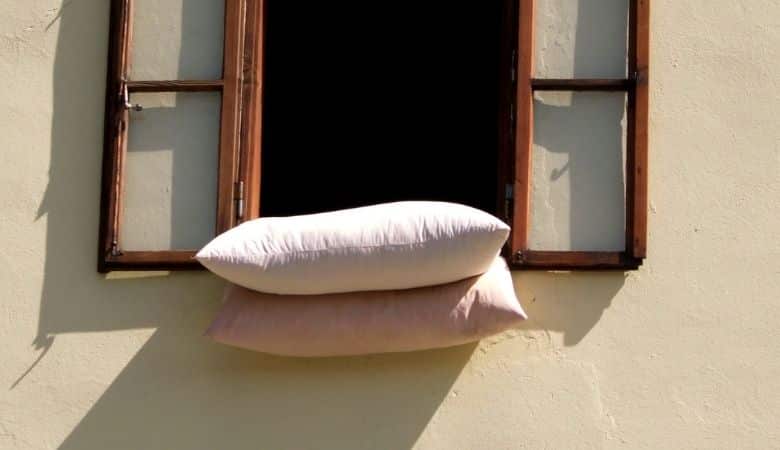
After washing your pillow either in the machine or by hand, you need to let it dry. A dry pillow smells lovely and feels fresh. It also feels more comfortable because you will not feel any wet spots. The two methods to dry your wool pillows are sun drying and machine drying.
Machine drying wool pillows
Step 1: Place the pillow in a dryer
Before placing the pillow in a dryer, leave it outside until it does not drip any water. Place the pillow in the dryer and balance the load. You should only add light fabrics because your pillow buffs when drying. Doing this ensures that your pillow gets enough rotation space.
Step 2: Set the dryer
Always set your dryer to low heat, especially for pillows made of wool, down, feather, or cotton. High temperatures can give foul odors when you take your wool pillow out. High temperatures can also tighten your pillow cover fabric.
You can also use the air-drying function on the machine to remove excess moisture and fluff your pillow.
Step 3: Place dryer balls or tennis balls
The balls will bounce all over to beat your pillow and target the clumps when the drum rotates. This process also helps your pillow regain its fluffiness when it is dry. The wool fibers can detangle and retain the pillow’s comforting properties.
If you use stuffed animals or tennis balls, place them inside a cloth or sock to prevent the lint from sticking.
Step 4: Start your dryer
Your pillows will take longer to dry when using low heat. Wool fibers are thick and can hold excess moisture, meaning you will leave them for more than 40 minutes. You can place it on another cycle for 30 minutes to thoroughly dry the corners and edges.
Shake your pillows after removing them from the dryer to fluff them and make them loftier.
Squeeze your pillows on all sides to confirm whether there is moisture. Sniff the pillow for any odors and detergent smells.
How to Sun-Dry a Wool Pillow
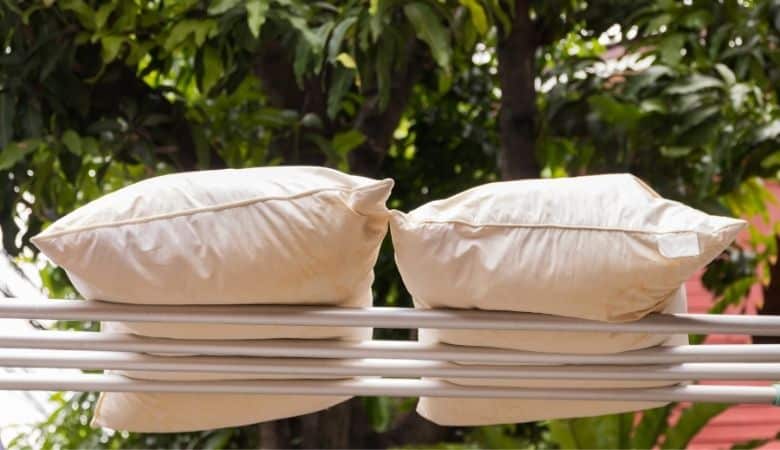
Always try and wash your pillows on a sunny day. Your pillow will dry better in the sun, where there is air circulation. Hang the pillow on the clothesline to expose both sides to sunshine.
When airing your pillow on a flat surface, keep checking and turning it on all sides to get sunlight. You can also massage it from time to time to break any tangible clumps you can feel.
If your pillow is adjustable, you can check for the zipper on the side to access the filling. Take out all wet filling and place them on a towel or bedsheet to dry in the sun. Keep turning the filling and massaging the fibers to break down any lumps.
If the pillow does not have a removable cover, you can bust the edges to remove the fillings. Only do this if you know how to stitch back the edges. Once the filling is dry, please return them to the pillow and sew the opening to prevent them from falling out.
When Should You Wash Your Wool Pillow?
- If there are noticeable stains on your pillow, maybe you poured some soup or hot chocolate on it. You need to clean it to prevent bacteria build-up and dust mites.
- An overused and dirty pillow releases some odor that makes your sleep uncomfortable. If the smell does not go away with some lavender spray, it is time to wash it and make it fresh again.
- If you sneeze a lot at night or when you wake up. When too much dirt builds up on your pillow, your nose will always be in trouble. You will inhale the dust and trigger allergic reactions that cause you to sneeze endlessly. Washing your pillow can help restore your pillow and remove dust mites.
- Suppose you are having an acne or pimple breakout. Dirty pillows cause skin irritation that causes acne and pimples. Cleaning your pillows regularly helps keep your face smooth and free of breakouts.
- If you sweat a lot at night, especially in the summer. A pillow without moisture-wicking can absorb sweat in the wool filling. Make it a routine to wash your pillow every four months to prevent the sweat from spreading into your pillow.
How to Keep Your Pillow Clean For Longer
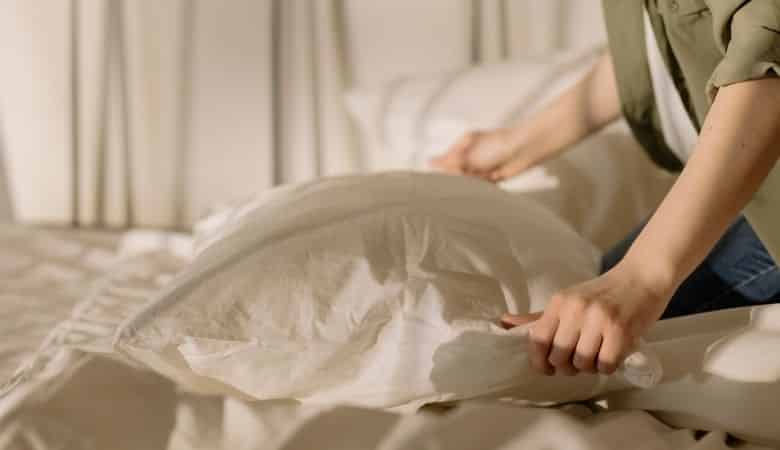
1. Use a pillowcase
When you buy a new wool pillow, place it inside a pillowcase to prevent the pillow cover from getting stained.
You can use either cotton, polyester, or bamboo pillow covers that are easy to clean. Also, get a pillowcase with moisture-wicking to prevent sweat absorption.
2. Have many pillowcases
A pillowcase can protect your pillow, but it gets dirty quickly since it is directly in contact with your body.
Even though washing might help keep it clean, you must have other pillowcases. Having many pillowcases help preserve your pillow by bringing freshness into your bed.
3. Avoid eating near or on your pillow
It is very tempting to eat or drink soup in bed, which may affect your pillow. If you have to east around your pillow, cover it with a piece of fabric to prevent staining.
For example, if you spill coffee on your pillow, it might force you to replace it a get a new one.
How Frequently Should You Wash a Wool Pillow?
You should wash your wool pillow every four to six months. Frequently, washing your pillow can damage the wool fibers, so you must control the amount of water it is exposed to. After four months, it is advisable to wash your pillow to eradicate dust, moisture, and body fluids.
Even though maintaining your pillow can help it last longer, you should keep track of its expiry date. The wool pillow manufacturer will state the exact time to replace your pillow. In the meantime, you can spot clean your pillows to remove stains and keep the pillow cover clean.
Dirty pillows are bad for your sleep and health, and you should avoid them as much as possible. Washing your pillows should be part of your routine to ensure you sleep healthy.
Wool pillows are delicate, and they need plenty of attention when cleaning them. Always follow instructions and cleaning directions to improve your experience. The instructions provided above should be enough to give your pillow life by restoring it to its original state, and also making it last longer.
Frequently Asked Wool Pillow Washing Questions
Can a wool pillow be dry cleaned?
Yes. A wool pillow is dry cleaning compatible, but most brands recommend against it. Dry cleaning can shrink your wool and damage them further if poorly done.
That is why you are always advised to read the product instructions to understand how the pillow maker wants you to use the product. Doing anything against the instructions can void your warranty if you need a replacement.
How should I wash a pillow without instructions?
Some pillows do not have care instructions though they are rare. If you have one of these, then do not use guesswork. Clean your pillow using a sponge or damp cloth to maintain the cover quality. Do not fully submerge your pillow because it might ruin the filler.
Alternatively, you can look for a professional cleaner who has experience cleaning different types of pillows. Also, please do not use any conditioner because it can break down the fibers.
Wool Pillows: A Complete Buyers Guide – Parts:
1. Why Use a Wool Pillow? The Benefits & Drawbacks
2. Wool vs. Down Pillows: Similarities, Differences & Which to Choose
3. How Long Do Wool Pillows Last? This is The Replacement Time
4. Do Wool Pillows Sleep Hot or Cool? Or Both Depending on The Climate?
5. Why do Wool Pillows Get Lumpy? How to “Unlump” Them
6. How to Soften a Wool Pillow: Step by Step Guide
7. How to Wash And Dry a Wool Pillow: Step by Step Guide
8. Best Wool Pillows of 2022 – Complete Review
